oceanbound
Contributor
Very sad story
Welcome to ScubaBoard, the world's largest scuba diving community. Registration is not required to read the forums, but we encourage you to join. Joining has its benefits and enables you to participate in the discussions.
Benefits of registering include
(Warning, may be long and too detailed; feel free to skip!)BTW, What sort of things would a person look for on a boat, that would indicate maintenance problems? I'm guessing you don't want to see too much duct tape and baling wire.
I check out the whole operation: Do they seem conscientious? Are things -- if not completely shiny around the shop and on the boat -- at least tidy? Does the captain seem like the sort of person who is conscientious? How seriously does he or she approach the safety briefing? Does he/she sort of laugh off the idea of a problem, or discuss the possibility and explain how to handle it?
This makes the most sense so far I'd say. A lot of information on the boat construction, sea conditions, and events just preceding the sinking is missing, but the prospect that small following seas alone sank the boat seems hard to believe, unless there were some serious gaps under serious desk wash. There must have been a leak below decks as well. That, and some big holes, would make the thrust, squat and sink theory a possibility.I wonder if the boat had a leak. It operated for years with removable hatches. If there was a leak the hull would be loaded with water, when the boat was throttled up all the water that was evenly distributed would rush to the back of the boat, sinking the stern, followed by everyone on board.
I just read the Herald story, it does sound like a pretty good leak
Seatow, a commercial salvage company, worked Monday afternoon to recover the boat and bring it back to land. The boat was brought to the surface, and the water pumped out. But it sank again.
Read more here: One dead, seven saved on sinking charter boat in Upper Keys - Florida Keys - MiamiHerald.com
I've been on deck and taken a 6ft wave in the face (6ft above the deck that is) fully expecting to be washed overboard, or sunk. Twenty seconds later, the deck was clear and we were still underway.
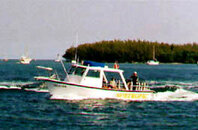
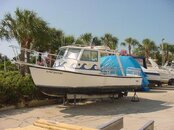
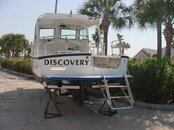
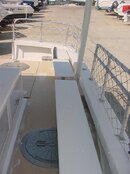
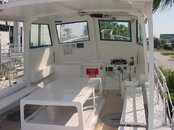
This makes the most sense so far I'd say. A lot of information on the boat construction, sea conditions, and events just preceding the sinking is missing, but the prospect that small following seas alone sank the boat seems hard to believe, unless there were some serious gaps under serious desk wash. There must have been a leak below decks as well. That, and some big holes, would make the thrust, squat and sink theory a possibility.
The trapping of passengers is also hard to imagine, with even a minute of warning, unless one was in the head or in the bilge trying to deal with the problem. The only thing that comes to mind is a concern I've had - when things start to go bad you're supposed to be instructed to put on your flotation gear. That pretty much guarantees that when things go topsy turvy, you'll have a hard time swimming out of anywhere that's underwater. It also leaves a lot of sturdy strapping to catch on things.
But again, with one or two minutes notice on a boat that simply sinks by the stern, there should have been time to get free of the boat.
One recreational diver is dead and another was in critical condition Monday after a commercial dive boat overturned Sunday afternoon at Molasses Reef with the captain, a crew member and six passengers aboard, according to the Florida Fish and Wildlife Conservation Commission.
Aimee Rhoades, 36, of Washington state, was one of two divers trapped below deck on the dive vessel Get Wet, which is operated by the Scuba Shack in Key Largo. Rhoades was pronounced dead by paramedics with the Key Largo Volunteer Ambulance Corps at the docks at John Pennekamp Coral Reef State Park, said FWC spokesman Bobby Dube. The other diver, Amit Rampurkar, 27, of New York, was airlifted to Baptist Hospital in Miami, where he was in critical condition Monday, Dube said.
The 24.5-foot vessel had just left a mooring at Molasses Reef and was powering up when the captain noticed the boat was taking on water, said Dube. The boat quickly capsized and sank, trapping two of the six customers in the forward cabin.
A nearby boater on the vessel Visibility contacted Coast Guard Station Islamorada at 3:15 p.m. as it helped rescue divers from the Get Wet, according to Coast Guard spokesman Petty Officer 2nd Class Nick Ameen. The captain of the Get Wet, who was not identified by the Coast Guard or FWC, dove into the submerged cabin and pulled Rhoades and Rampurkar to the surface. Both reportedly were unconscious.
Both were taken aboard the Visibility, where CPR was administered as they were rushed to Pennekamp, said Ameen. Neither the Coast Guard nor the FWC released the names of those aboard Visibility who helped with the rescue.
"The Coast Guard is thankful for Good Samaritans on the water who maintain a watchful eye and stand ready to assist boaters in distress," Coast Guard Capt. Pat DeQuattro said in a prepared statement. "Our thoughts are with the family and friends of the victims of this tragic occurrence."
A commercial salvage company has been contacted to salvage the vessel. Ameen said the Coast Guard is investigating the sinking.
The Scuba Shack opened a year ago at the Seafarer Resort in Key Largo. No one answered the phone at the scuba business Monday.
Molasses Reef is southeast of Key Largo and just east of John Pennekamp Coral Reef State Park.
Aimee Rhoads, 36, a tourist diver from Washington state, was pronounced dead after emergency workers performing CPR could not revive her on Sunday (December 18). Rhoads reportedly was trapped inside the cabin of a 25-foot charter boat that quickly sank in choppy seas in the Florida Keys.
Amit Rampurkarl, 27, of New York, also was trapped inside the cabin of the charter boat called "Get Wet," which is owned and operated by Key Largo Scuba Shack. Rampurkarl survived and was taken to Baptist Hospital in Kendall, although he remains in critical condition.
The other six people aboard the boat, including the captain and one crew member, all survived with no major injuries.
COMMENT: The tragedy happened not long after the divers completed their first of two planned dives on Molasses Reef, a popular spot about 30 feet deep and a few miles offshore of Key Largo in the Atlantic Ocean. The boat had just left one mooring spot and was enroute to a second dive location on the large reef when it began taking on water. The boat sank in less than three minutes.
Captain John Nathaniel dove into the cabin and retrieved Rhoads and Rampurkarl, who were unconscious. They were put on a commercial vessel from Pennekamp Park called "Visibility" that had arrived to help, and both were given CPR en route to Key Largo.
Key Largo Scuba Shack, which opened August 2010, has suspended its operations while investigators from the Florida Fish and Wildlife Conservation Commission and the US Coast Guard determine what happened.
The weather started out fairly calm but the winds picked up and the seas got choppier as the day progressed. The accident happened at about 1515, when winds were at least 15 mph and the seas were 3 to 4 feet.
Updates will be provided on this accident as information becomes available.
